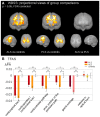White Matter Microstructure Breakdown in the Motor Neuron Disease Spectrum: Recent Advances Using Diffusion Magnetic Resonance Imaging
- PMID: 30891004
- PMCID: PMC6413536
- DOI: 10.3389/fneur.2019.00193
White Matter Microstructure Breakdown in the Motor Neuron Disease Spectrum: Recent Advances Using Diffusion Magnetic Resonance Imaging
Abstract
Motor neuron disease (MND) is a fatal progressive neurodegenerative disorder characterized by the breakdown of the motor system. The clinical spectrum of MND encompasses different phenotypes classified according to the relative involvement of the upper or lower motor neurons (LMN) and the presence of genetic or cognitive alterations, with clear prognostic implications. However, the pathophysiological differences of these phenotypes remain largely unknown. Recently, magnetic resonance imaging (MRI) has been recognized as a helpful in-vivo MND biomarker. An increasing number of studies is applying advanced neuroimaging techniques in order to elucidate the pathophysiological processes and to identify quantitative outcomes to be used in clinical trials. Diffusion tensor imaging (DTI) is a non-invasive method to detect white matter alterations involving the upper motor neuron and extra-motor white matter tracts. According to this background, the aim of this review is to highlight the key role of MRI and especially DTI, summarizing cross-sectional and longitudinal results of different approaches applied in MND. Current literature suggests that DTI is a promising tool in order to define anatomical "signatures" of the different phenotypes of MND and to track in vivo the progressive spread of pathological proteins aggregates.
Keywords: amyotrophic lateral sclerosis; diffusion tensor imaging; fractional anisotropy; magnetic resonance imaging; motor neuron disease; network analysis; structural connectomics.
Figures


Similar articles
-
Upper and extra-motoneuron involvement in early motoneuron disease: a diffusion tensor imaging study.Brain. 2011 Apr;134(Pt 4):1211-28. doi: 10.1093/brain/awr016. Epub 2011 Feb 28. Brain. 2011. PMID: 21362631
-
Structural brain correlates of cognitive and behavioral impairment in MND.Hum Brain Mapp. 2016 Apr;37(4):1614-26. doi: 10.1002/hbm.23124. Epub 2016 Feb 2. Hum Brain Mapp. 2016. PMID: 26833930 Free PMC article.
-
Differential involvement of corticospinal tract (CST) fibers in UMN-predominant ALS patients with or without CST hyperintensity: A diffusion tensor tractography study.Neuroimage Clin. 2017 Feb 22;14:574-579. doi: 10.1016/j.nicl.2017.02.017. eCollection 2017. Neuroimage Clin. 2017. PMID: 28337412 Free PMC article.
-
A review of cervical spine MRI in ALS patients.J Med Life. 2018 Apr-Jun;11(2):123-127. J Med Life. 2018. PMID: 30140318 Free PMC article. Review.
-
The role of diffusion tensor imaging and fractional anisotropy in the evaluation of patients with idiopathic normal pressure hydrocephalus: a literature review.Neurosurg Focus. 2016 Sep;41(3):E12. doi: 10.3171/2016.6.FOCUS16192. Neurosurg Focus. 2016. PMID: 27581308 Review.
Cited by
-
Simultaneous PET/MRI: The future gold standard for characterizing motor neuron disease-A clinico-radiological and neuroscientific perspective.Front Neurol. 2022 Aug 17;13:890425. doi: 10.3389/fneur.2022.890425. eCollection 2022. Front Neurol. 2022. PMID: 36061999 Free PMC article. Review.
-
Structural and functional brain connectome in motor neuron diseases: A multicenter MRI study.Neurology. 2020 Nov 3;95(18):e2552-e2564. doi: 10.1212/WNL.0000000000010731. Epub 2020 Sep 10. Neurology. 2020. PMID: 32913015 Free PMC article.
-
Toward diffusion tensor imaging as a biomarker in neurodegenerative diseases: technical considerations to optimize recordings and data processing.Front Hum Neurosci. 2024 Apr 2;18:1378896. doi: 10.3389/fnhum.2024.1378896. eCollection 2024. Front Hum Neurosci. 2024. PMID: 38628970 Free PMC article. Review.
-
Microstructural Changes in the Corpus Callosum in Neurodegenerative Diseases.Cureus. 2024 Aug 21;16(8):e67378. doi: 10.7759/cureus.67378. eCollection 2024 Aug. Cureus. 2024. PMID: 39310519 Free PMC article. Review.
-
Diffusion tensor imaging biomarkers and clinical assessments in amyotrophic lateral sclerosis (ALS) patients: an exploratory study.Ann Med Surg (Lond). 2024 Jul 23;86(9):5080-5090. doi: 10.1097/MS9.0000000000002332. eCollection 2024 Sep. Ann Med Surg (Lond). 2024. PMID: 39239063 Free PMC article.
References
-
- Rafalowska J, Dziewulska D. White matter injury in amyotrophic lateral sclerosis (ALS). Folia Neuropathol. (1996) 34:87–91. - PubMed
Publication types
LinkOut - more resources
Full Text Sources
Research Materials

